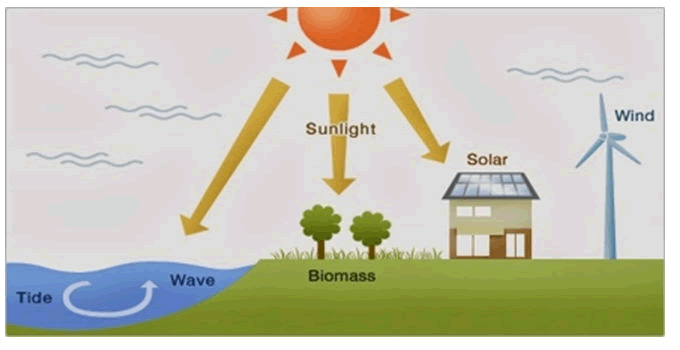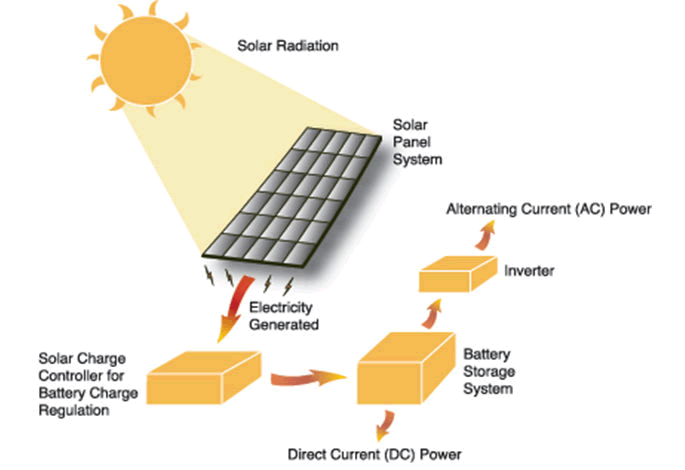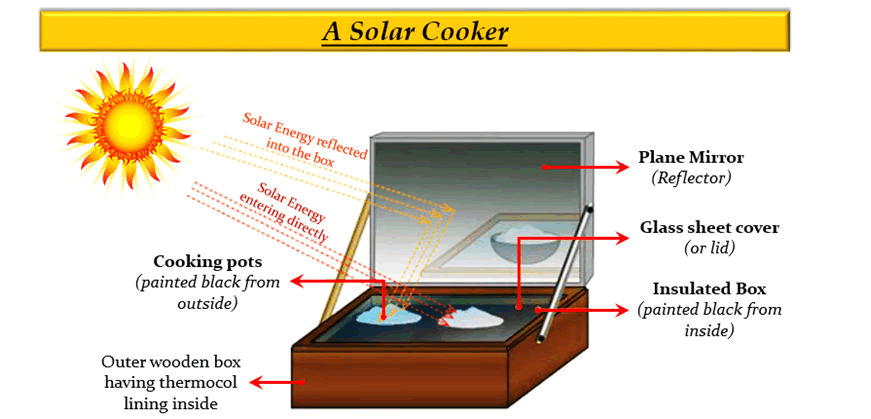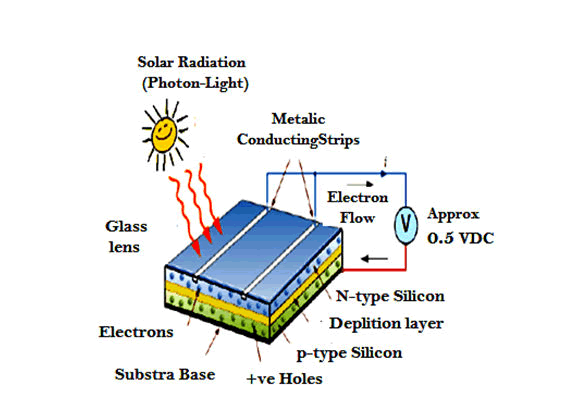Review Article, J Nucl Ene Sci Power Generat Technol Vol: 11 Issue: 4
A Review Study on Solar Energy and Its Various Applications
Satish Saini1*, Ankit Tyagi2 and Rishi Sikka3
1Department of Physics, RIMT University, Mandi Gobindgarh, Punjab, India
2Department of Electrical and Electronic Engineering, Teerthanker Mahaveer University, Uttar Pradesh, India
3Department of Electrical and Electronic Engineering, Sanskriti University,Mathura, Uttar Pradesh, India
*Corresponding Author : Satish Saini, Department of Physics, RIMT University, Mandi Gobindgarh, Punjab, India, E-mail: satishsaini@rimt.ac.in
Received date: 03 November, 2021, Manuscript No. JNPGT-21-46545;
Editor assigned date: 05 November, 2021, PreQC No. JNPGT-21-46545 (PQ);
Reviewed date: 19 November, 2021, QC No. JNPGT-21-46545;
Revised date: 03 January 2022, Manuscript No. JNPGT-21-46545 (R);
Published date: 23 March 2022, DOI: 10.4172/2325-9809.1000260
Citation: Satish S, Ankit T, Rishi S (2022) A Review Study on Solar Energy and Its Various Applications. J Nucl Ene Sci Power Generat Technol 11:4.
Abstract
Solar energy is a type of thermal energy that can be captured using a variety of advanced developing technologies, such as photovoltaic and solar thermal energy. Conventional harnessing methods rely on non-renewable energy source, which have a significant negative impact on the environment since they release a variety of hazardous and poisonous gases. Sun energy is one of the most favourable and best non-renewable energy resources that may be utilised as a main energy source as well as for the generation of secondary energy resources like electricity and steam. Solar energy has two key advantages: it is readily available and produces less pollution. Electricity generation is a primary application of solar energy that is widely used across the world. This review article provided a high-level summary of solar energy and its potential uses. Solar-energy has the potential to assist meet the energy demands of a growing population in a more efficient manner in the future.
Keywords: Conventional energy, Electricity photovoltaic cell, Renewable energy, Solar Energy, Thermal energy
Introduction
Non-renewable resources are natural resources that do not regenerate at the same rate as they are consumed. There are only a few left. Fossil fuels like natural gas, oil, as well as coal are examples of non-renewable resources. Humans destroy these substances' stores on a regular basis, but new supplies take millennia to produce. These non-renewable resources aid power plants by allowing them to produce more electricity on demand. These energy resources are utilised in two ways: as primary energy resources, such as gasoline and diesel, which are directly used in vehicles, and for the creation of secondary energy resources, such as electricity and steam, which are produced using coal and petroleum products. We have already used 60% of the entire storage capacity of non-renewable energy resources, which is why further excessive usage of non-renewable energy resources may result in future energy instability. Aside from this issue, one of the primary drawbacks of non-renewable energy resources is the creation of hazardous and poisonous gases. The release of these gases in the air causes environmental harm. Climate change and global warming are caused by rising levels of nitrous oxide, carbon monoxide, Sulphur dioxide and carbon dioxide [1].
Renewable energy resources have being explored at a larger scale to address such challenges. The availability of renewable energy supplies is a key benefit, as is the absence of hazardous gases and other poisonous pollutants. Wind energy, solar energy, geothermal energy, and hydropower are some of the most prevalent renewable energy sources. While non-conventional energy sources have the advantage of having an unlimited supply throughout time, their availability at any one moment is limited. The sun, for example, rises every day, but its capacity to create electricity is restricted when it is cloudy. Another drawback is that power plant operators are unable to ramp-up renewable energy output when peoples consume more electricity. On a hot day, for example, when a large number of people are using air conditioning units at the same time.
Literature Review
One of the most promising energy sources is solar energy resources for consumption among all renewable energy options. The sun's energy reaches the planet in the form of solar radiation, which includes infrared, radio waves, UV rays, and gamma rays, among other things. The bulk of the sun's energy is in the form of heat, which may be used for a variety of purposes. Solar energy may be utilised as a main energy source as well as a secondary energy source for the generation of electrical energy and steam. Solar energy-based power plants are particularly beneficial in rural and other remote areas since they alleviate the load of transmission and distribution lines. Power generating is one of the most promising applications for meeting the rising demand for electricity among the world's expanding population. Solar power plants are now being built in both developed and developing countries so that energy may be generated in a green manner in the country. Aside from the numerous benefits, solar power-based energy generation also comes with a number of problems and issues. Weather dependence, limited efficiency, and a high initial setup cost are some of the most prevalent difficulties. These obstacles must be overcome in order to take this technology to the next level.
Solar energy and its related elements, such as materials, applications, and future possibilities, were examined in this review paper. This review article will also examine other renewable energy options, as well as compare and explain how solar energy is superior to other renewable energy sources. The thorough review of solar energy will aid researchers to understanding the principles of solar energy.
Renewable energy resourcesThe term "renewable energy resources" refers to a type of energy which both sustainable as well as clean and is abundant in nature. In terms of quantity, these energy supplies will never run out. Many academics have been paying close attention to these energy resources in the last few decades since they are considered futuristic energy resources (Table 1). The major benefits of these energy supplies are their availability and the lack of hazardous gas emissions [2].
| Renewable Energy Resource or Non-Conventional Energy Resource | Description |
|---|---|
| Solar Energy | Solar energy falls under the topic of renewable energy resources. The heat emitted by the sun as a result of the fusion reaction reaches the earth in some form. The earth's thermal energy is used in a variety of ways, including cooking, water heating, and power generation. Solar energy is becoming more and more popular as a means of reducing your energy use. Solar power is the transformation of solar energy to electric energy. The United States has some of the most available solar resource in the worlds. Solar technologies can be used to produce electricity, offer light or a warm interior environment, as well as water heating for residential, commercial, and industrial usage |
| Wind energy | The technique of harnessing the wind to produce mechanical or electrical energy is known as wind power or wind energy. The kinetic energy of the wind is converted into mechanical energy by wind turbines. This mechanical power may be put to particular uses or turned into electricity with the help of a generator. Wind turbines are used to generate power. It is made of blades and a generator. When the wind blows across the blades, it turns the generator, which generates energy. |
| Geothermal energy | The energy of the ground is referred to as geothermal energy. Because the earth's inner core has a very high temperature. When a suitable liquid is injected into the earth, steam is produced when the liquid evaporates owing to the high temperature of the core. After that, the steam is sent to the turbines. The turbine is rotated by the steam pressure, which produces energy. |
| Biomass Energy | The process of turning solid fuel from plants into energy is known as biomass conversion. Although biomass is basically a method of producing power via the combustion of organic materials, it is now a cleaner and energy-efficient process. Biomass provides power at a much lower economic and environmental cost by converting agricultural, business, and residential waste into solid, liquid, as well as gas fuel. |
Table 1: The below Table shows the primary renewable energy resources available.
Solar energyThe sun-generates solar energy, which is a type of heat energy. The fusion process that takes place on the sun's surface is the primary source of the heat energy. Due to the many drawbacks connected with non-renewable energy resources, the use of solar energy has improved during the previous two decades. The primary disadvantages of nonrenewable energy supplies include the high levels of hazardous gas emissions into the environment, such as SO2, NOx, and CO. These gases contribute to increased air pollution, which has resulted in a slew of issues, including climate change and global warming. Renewable-energy has been regarded most promising alternatives to non-renewable energy supplies in order to solve such difficulties. Solar energy is a form of renewable-energy that will never be depleted in terms of supply as shown in [3] Figure 1.
The Sun's solar energy is distributed evenly in all directions, and other planets, like Earth, get solar energy from the Sun, although at varying intensities. The intensity of solar energy is determined by the distance between the sun and the planet, as well as the planet's atmospheric conditions. The intensity of the sun is affected by the varied layers of gases and particles that each planet has. Solar energy received on Earth has a relatively low power density, ranging from 0 to 1.2 kW/m2. Given the importance of solar energy, numerous facilities have been constructed in recent years in various nations to generate power on a greater scale [4].
Solar energy may be used in two ways as a primary energy resource a primary energy resource can be used directly for a variety of applications. Solar energy can be utilised directly for cooking and water heating, as well as for the creation of secondary energy resources: secondary energy resources are energy resources that are created from primary energy resource or convert primary resources to another energy resources. Electricity and steam, for example, are two of the most prevalent secondary energy resources. One of finest applications of solar energy is electricity generation, which is also one of the most promising. Solar energy-based power generation is particularly beneficial in remote and rural locations. It aids in the production of power locally, resulting in a decrease in the transmission and distribution of electricity. It also aids in the development of local infrastructure.
Applications of solar energyRenewable energy resources have a wide range of applications and may be employed as primary energy resources as well as for the generation of secondary energy resources by converting themselves to energy resources. Solar energy resources, like other renewable energy sources, offer a wide range of uses and may be employed according to the energy need. Some of the application of solar energy as follows [5].
Generation of solar electricityPhotovoltaic cells may use solar energy to produce electricity or vice versa. A photovoltaic cell is a kind of energy conversion technology that directly transforms photons from sunlight into electricity. Semiconductors absorb photons out from sun and generate high-energy free electrons. An electric field causes these high-energy free electrons to flow-out of the semiconductors and do meaningful work. In solar cells, the electric field is generally generated via a p-n junction of materials with differing electrical characteristics. Different manufacturing processes are used to ensure that these cells are as efficient as possible [6]. To construct cell modules, these cells are stacked in a parallel or series configuration. These modules provide a variety of benefits, including high dependability, no fuel use, minimal maintenance expenses, long life, mobility, adaptability, as well as pollution-free operation as shown [7] in Figure 2.
Photovoltaic cells have been used to power irrigation pumps, rail crossing warnings, navigational signs, interstate emergency call systems, automated meteorological stations, and other equipment in locations where power lines are hard to establish. They're also used to monitor the weather and provide portable power for TVs, calculator, clocks, computer card, battery charging, and satellites, among other things. Aside from these uses, photovoltaic are used to power irrigation pumps, drinking water supply pumps, and energy distribution in rural regions, including such street lighting, figure 2.
Solar collectorA sunlight collector is a device that collects as well as concentrates solar energy from the Sun. These devices are commonly used for active solar thermal and allow for personal water heating [8]. Given the fact that they will be exposed to a variety of weather conditions, these collectors are typically placed on the roof and should be very robust. These solar collectors may be used instead of a water heater to heat water in the house, perhaps saving money in the long term. A significant number of these collectors may be put together in an array and used to produce electricity in solar thermal power plants and in homes. Each collector class has its own set of benefits that can be used based on the application. Some are affordable and simple to maintain, while others are costly and need extensive care yet provide great efficiency. Best solar heat collectors may be chosen from a broad selection of solar heat collectors depending on the demand.
Types of solar collectorsSolar collectors are available in a wide range of forms as well as sizes, but they all follow the same fundamental design principles. In general, some material is utilized to collect and concentrate solar energy in order to use it to heat water. Some of the solar collector are as follows:
- Flat Plate Collectors
- Point Focus Collectors
- Evacuated Tube Collectors
- Line Focus Collectors
A solar cooker is a kind of solar cooker that uses the sun to cook. The solar cooker works on the idea that the sun heats the pot in which the food is prepared. By turning light energy into heat energy, the pot gets warmed up. Concave mirrors are utilized in these kinds of cookers because they reflect light into a single focus point. The sun's rays are concentrated by the mirror onto a receiver, such as a frying pan [9]. UV light rays enter a solar cooker and are converted to longer infrared light rays, which cannot escape. When food is exposed to infrared radiation, water, fat, and protein molecules vibrate energetically and heat up. The process of light energy interacting with the receiver material and turning light to heat is known as conduction (Figure 3). Using heat-conducting and heat-retaining materials, we may maximize this transition.Solar cookers are divided into two categories (Figure 3).
- Box Type
- Parabolic Type
A blackened flat-plate solar metal collector with accompanying metal tubing oriented in the overall direction of the sun makes up a solar water heating system. Above the plate collector is a clear glass cover with a layer of thermal insulation underneath it. A conduit connects the collector's metal tubing to an insulated tank that keeps the hot water warm on overcast days. The collector collects solar energy and then transfers the heat to the water running down the tube, either by gravity or with the aid of a pump. A metal tube transports the hot water to the storage tank. Hotels, guest homes, tourist bungalows, clinics, cafeterias, as well as residential and industrial institutions, utilize this kind of water heating system [10].
Solar cellsPhotovoltaic (or solar) technology is a type of semiconductor device that uses solar radiation to generate electricity. It is a pn-junction based semiconductor device composed of two types of extrinsic semiconductor materials: n-type and p-type semiconductor materials. A pentavalent impurity is added to the pure semiconductor material to create the n-type semiconductor material. The materials with the five valence electrons in the outermost orbit are known as pentavalent impurities. Phosphorous and antimony are two of the most frequent pentavalent impurities. When pentavalent impurity is added to silicon, for example, all valence electrons form covalent bonds with the neighboring four valance electrons of the pentavalent impurity, resulting in the formation of n-type silicon [11]. Following the establishment of covalent connection between the impurity atom and the pure material atom, a fifth electron remains unattached to the parent impurity atom and is weakly bound. By giving the atom a little amount of energy, these fifth electrons can be freed. Because the excess fifth electrons increase the amount of free charge carriers in the material, electrons are the common charges carriers in n-type of semiconductor, whereas holes are the smaller charge carriers. A trivalent impurity is added to pure semiconductor material to create p-type semiconductor material. The doping process is the addition of an impurity to a pure semiconductor material. The three electrons in the outermost orbit are found in trivalent impurities. When a trivalent impurity is introduced to a pure semiconductor material, a vacancy is produced with a positive charge equal to the electron's charge magnitude. These vacancies are commonly referred to as holes, and they serve as charge carriers by accepting electrons. Because electrons have a higher mobility than holes, electrons provide more current. Charge carrier mobility in the germanium material is greater than that of silicon, resulting in better conductivity.
However, silicon is preferred over germanium because it has better thermal stability and can withstand greater temperatures. When these p and n-type semiconductor materials are joined together using the semiconductor unit method, a pn-junction device, also known as a photovoltaic or solar cell device, is formed. When sunlight strikes the devices, the covalent bonds in both types of semiconductor materials are broken, resulting in the generation of a greater number of electron and hole pairs. Because their polarity charges are opposing, these charge carriers travel in opposite directions. The current flow in the device is caused by the flow of charge carriers in the device as shown in Figure 4 [12].
Discussion
Renewable energy has attracted a lot of interest from academics in recent years since it is seen as the most viable alternative to non-renewable energy sources with natural gas, coal, as well as nuclear power. Non-renewable energy resources produce a considerable number of hazardous gases and other toxic pollutants, which have a significant negative influence on the environments. Air pollution is the most prevalent problem linked with non-renewable energy resources. Air pollution contributes to a variety of issues, including climate change and global warming. On the other hand, the renewable energy resources are green in nature and available in the nature in unlimited quantity. Among the all renewable energy resources, solar energy is considered most promising energy resource for the electricity generation. In recent years, solar energy utilized for the electricity generation at larger scale. Some of the most common applications of the solar energy are solar cells, solar power plant, solar heat collectors, solar cooking and water heating. In some cases, solar energy directly utilizes and in some cases it can be utilized for the production of other energy resources such as electricity and steam. From the last few years, many developed as well as developing countries have been established solar power plants in order to fulfil the demand of the electricity by growing population [13].
Conclusion
In order to meet the rising need for energy, solar energy is regarded the most promising energy resources. Solar energy has several advantages over non-renewable energy sources, including availability and the absence of hazardous gas emissions. Solar energy may be used without causing harm to the environment. Many power production firms have been paying close attention to it in recent years in order to shift their reliance from non-renewable energy supplies to solar power. Despite its numerous advantages, solar energy has significant disadvantages, such as a high initial cost, weather dependence, and low efficiency, among others. Since sunlight is not available in the bad weather conditions as well as in night, that is why an additional storage system is required that leads to the high initial rate of the solar energy based system. In order to overcome such challenges, it is recommended that government must make a proper framework for the establishment of renewable energy based systems so that the cost can be reduce and also support the RD in this sector so that advancement in this field can be done time to time.
References
- Furlan C, Mortarino C (2018) Forecasting the impact of renewable energies in competition with non-renewable sources Renew Sustain Energy Rev 81: 1879-1886. [Crossref][Google Scholar][Indexing at]
- Ragazzi M, Ionescu G, Cioranu SI (2017) Assessment of environmental impact from renewable and non-renewable energy sources Int J Energy Prod Manag 2: 8-16. [Crossref][Google Scholar][Indexing at]
- Kuik O, Branger F, Quirion P (2019) Competitive advantage in the renewable energy industry: Evidence from a gravity model Renew Energy 131: 472-481. [Crossref][Google Scholar][Indexing at]
- Sadvakasova AK, Kossalbayev BD, Zayadan BK, Kirbayeva DK, Alwasel S, et al. (2021) Potential of cyanobacteria in the conversion of wastewater to biofuels World J Microbiol Biotechnol 37: 1-22. [Crossref][Google Scholar][Pubmed]
- Aboagye B, Gyamfi S, Ofosu EA, Djordjevic S (2021) Status of renewable energy resources for electricity supply in Ghana Sci Afr 11: e00660. [Crossref][Google Scholar][Indexing at]
- Avtar R, Sahu N, Aggarwal AK, Chakraborty S, Kharrazi A, et al. (2019) Exploring renewable energy resources using remote sensing and GIS: A review Res 8: 149. [Crossref][Google Scholar][Indexing at]
- Kannan N, Vakeesan D (2016) Solar energy for future world: A review Renew Sustain Energy Rev 62: 1092-1105. [Crossref][Google Scholar][Indexing at]
- Kabir E, Kumar P, Kumar S, Adelodun AA, Kim KH, et al. (2018) Solar energy: Potential and future prospects Renew Sustain Energy Rev.82: 894-900. [Crossref][Google Scholar][Indexing at]
- Sampaio PG, González MO (2017) Photovoltaic solar energy: Conceptual framework Renew Sustain Energy Rev 74: 590-601. [Crossref][Google Scholar][Indexing at]
- Herez A, Ramadan M, Khaled M (2018) Review on solar cooker systems: Economic and environmental study for different Lebanese scenarios Renew Sustain Energy Rev 81: 421-32. [Crossref][Google Scholar][Indexing at]
- Islam MR, Sumathy K, Khan SU (2013) Solar water heating systems and their market trends. Renew Sustain Energy Rev 17: 1-25. [Crossref][Google Scholar]
- Singh BP, Goyal SK, Kumar P (2021) Solar PV cell materials and technologies: Analyzing the recent developments. Materials today: Proceedings 43: 2843-2849. [Crossref][Google Scholar]
- Vergura S, Acciani G, Falcone O (2009) 3D PV cell model by means of FEM. Int Confer Clean Electric Power 35-40. [Crossref][Google Scholar][Indexing at]
 Spanish
Spanish  Chinese
Chinese  Russian
Russian  German
German  French
French  Japanese
Japanese  Portuguese
Portuguese  Hindi
Hindi 





